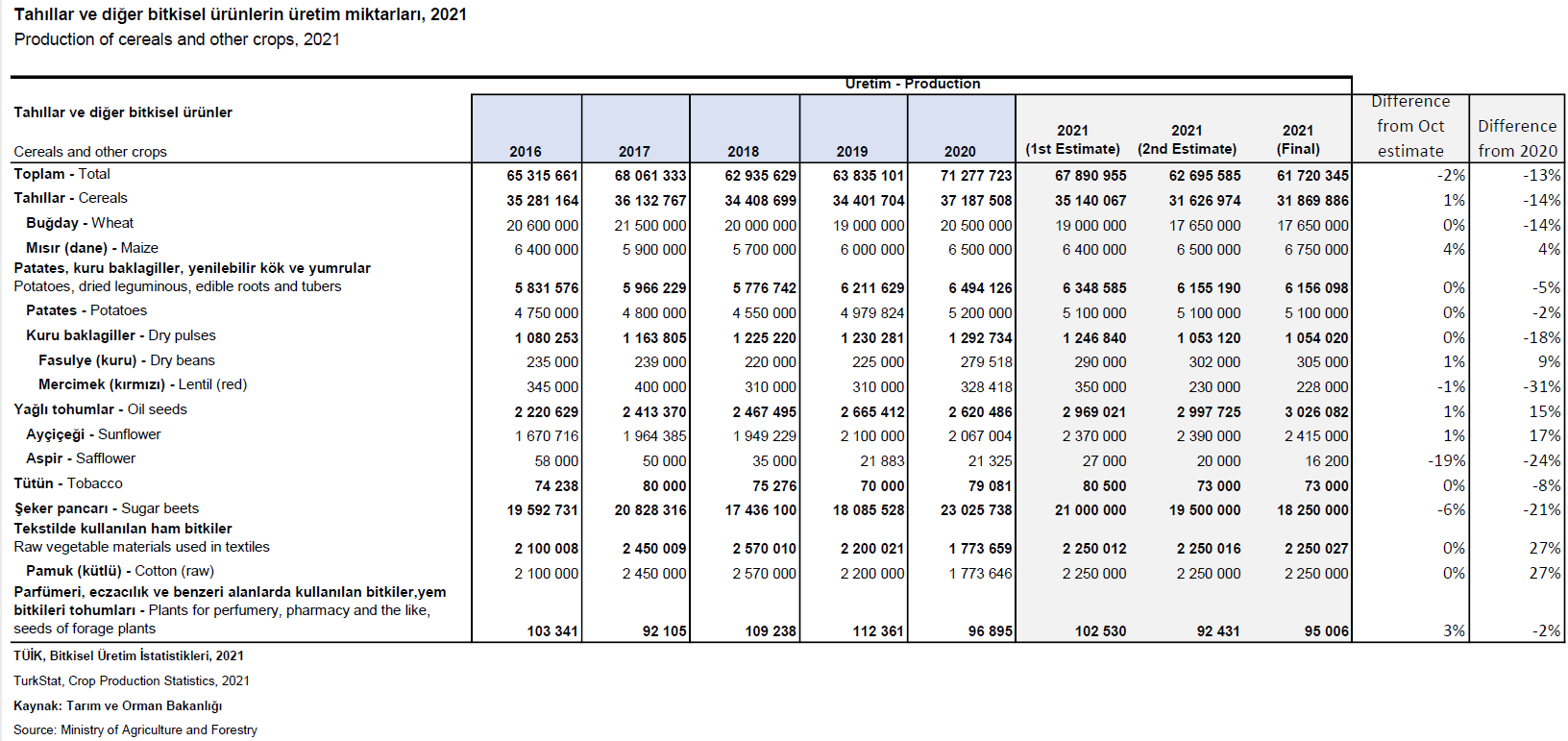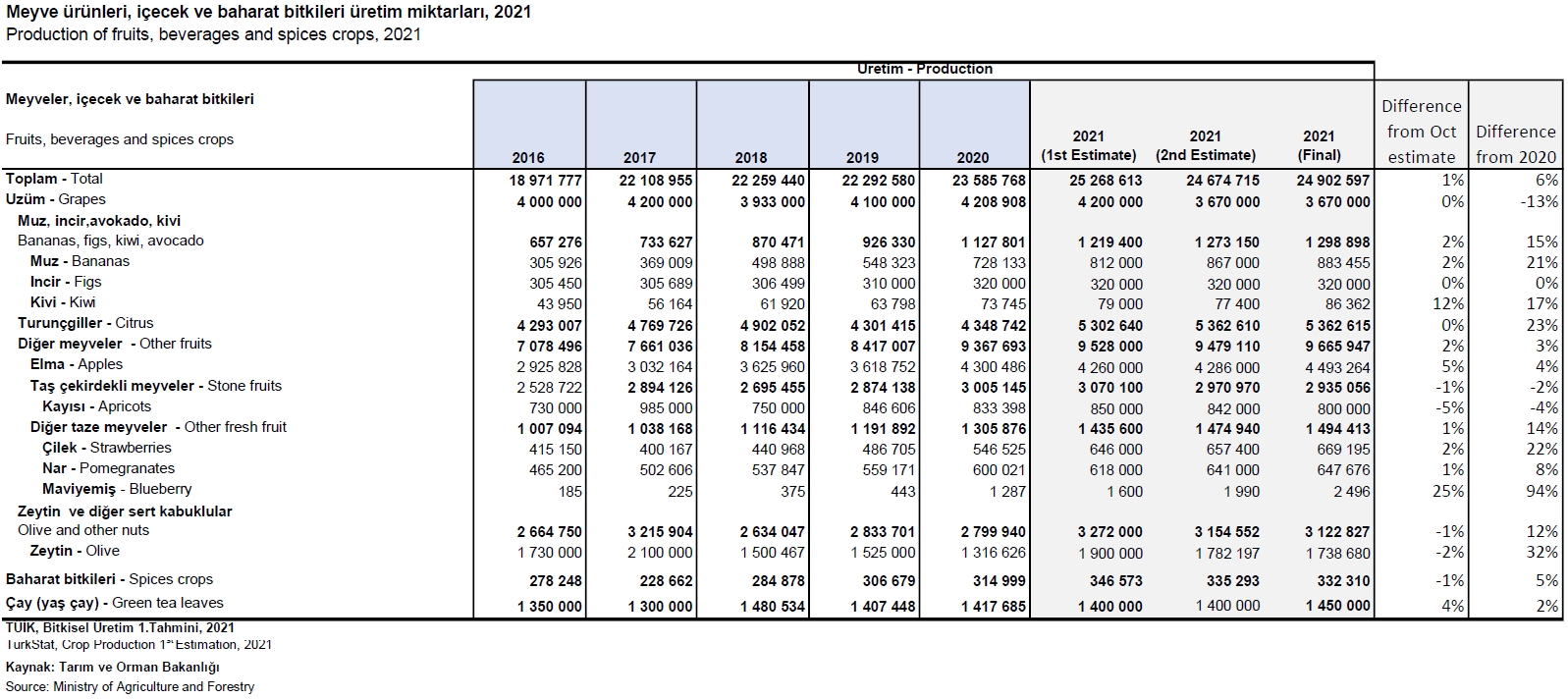Highlights from Turkey’s 3rd and final crop report for 2021

Turkey’s agricultural production and crop estimates
Turkey is an agricultural powerhouse, and according to FAO estimates, the world’s 7th largest exporter of agricultural products. Turkey is renowned for its nuts and dominates global production of dried fruit. It is also a major producer of grapes, citrus, and apples. Wheat and sugarbeets are two major field crops. A wide range of vegetables is also grown, with tomatoes being the primary crop.
Turkey’s statistical institute (TurkStat) releases 3 crop estimates throughout the year. The first in May, the second in October, and the last at the end of December. The 3rd “estimate” is, in fact, wrap-up of the crop production figures, called “Crop Production Statistics”.
Turkey is a huge producer of fruits and nuts, which means the bulk of agricultural products are harvested in Autumn (August to October). This means that when the December report is released, most numbers are already in.
Production of cereals and other crops
Cereal production estimates were lowered throughout the year as dry conditions continued over the main cereal regions. This persistent drought led to a drop in production in winter crops (wheat, barley, and oats), and sugarbeet production was also hit hard. Summer field crops (maize and sunflowers) fared better.
Maize production was surprisingly firm at 6.75 million MT for 2021, up 4% from the previous estimate. Safflower production for the year ended at only 16,200 MT, much lower than the initial estimate of 27,000 MT in May. Although safflower is only a small niche crop, production has plummeted from more than 50,000 MT only 4 years ago.
Sugarbeet production was reduced once again, to only 18.25 million MT, much lower than the initial estimate of 21.00 million MT in May.

*Only selected crops are illustrated. For the full estimate visit the TURKSTAT website.
Production of fruit, beverage, and spice crops
The total production of fruit, beverage, and spice crops was 24,902,597 MT. Several crops were estimated higher, with other estimates dropping. Overall Turkey is increasing fruit, beverage, and spice crop production.
Banana production is 883,455 MT, up 2% from the previous estimate, up 9% from the May estimate, and more than double four years ago. Bananas are now Turkey’s 7th largest fruit crop.
Although kiwi fruit production is still fairly small it has increased rapidly and stands at 86,362 MT, 12% more than the October estimate and nearly double 5 years ago. Both banana and kiwi production has skyrocketed, being underestimated throughout the year, which could be an indication that the expansion is still ongoing.
Apricot production is 5% less than the previous estimate. This could be disappointing, as the export demand for dried apricots has been strong after Turkey’s increased efforts to market their apricots to the far east in recent years.
The apple crop is 5% higher than the estimate in October and 2021 production is an incredible 4,493,264 MT. This is good news for apple exporters since they will already have a massive market for apples in Belarus. Belarus will implement a ban on the imports of certain food products from the EU starting January 1st, 2022. This should open the door for Turkish apples. In 2020, Belarus imported 130,520 MT of apples, of which 119,496 MT arrived from Poland and only 157 MT from Turkey.
While blueberry production, at 2,496 MT, is minute compared to other crops but has been expanding very rapidly. Production was underestimated by 25% in the October estimate, which could indicate a faster expansion than anticipated going forward.

*Only selected crops are illustrated. For the full estimate visit the TURKSTAT website.
Production of vegetables
Total vegetable production for 2021 is 31,753,466 MT, up 2% from the October estimate and also last year’s production.
The dried onion crop is an impressive 2.5 million MT, 4%more than previously estimated. Green garlic production is 42% more than the October estimate, but it is in part due to a switch from dried garlic to green garlic.
The carrot and green pepper crops also fared better than expected in the previous forecasts.

*Only selected crops are illustrated. For the full estimate visit the TURKSTAT website
The outlook for 2022
This final crop production report wraps up a comparatively good year in terms of production for Turkey, especially given tough climatic conditions, increasing costs of inputs, and disruptions to supply chains caused by global logistic bottlenecks. The Turkish lira has been on a rollercoaster ride for the last couple of months, but the generally weaker currency could make Turkish products more competitive in the export market, however it will also make inputs for the 2022 crop more expensive.
Turkey’s production of fruit, beverage, and spice crops has been performing well, expanding by an average of 6.25% per year since 2016. Products from this sector have been marketed aggressively and could open up new markets as production expands. The first crop estimate for the 2022 season will be released on the 27th of May, and Turkey will hope to maintain the momentum from the fruit, beverage, and spice crop sector going into next year.
Sources

